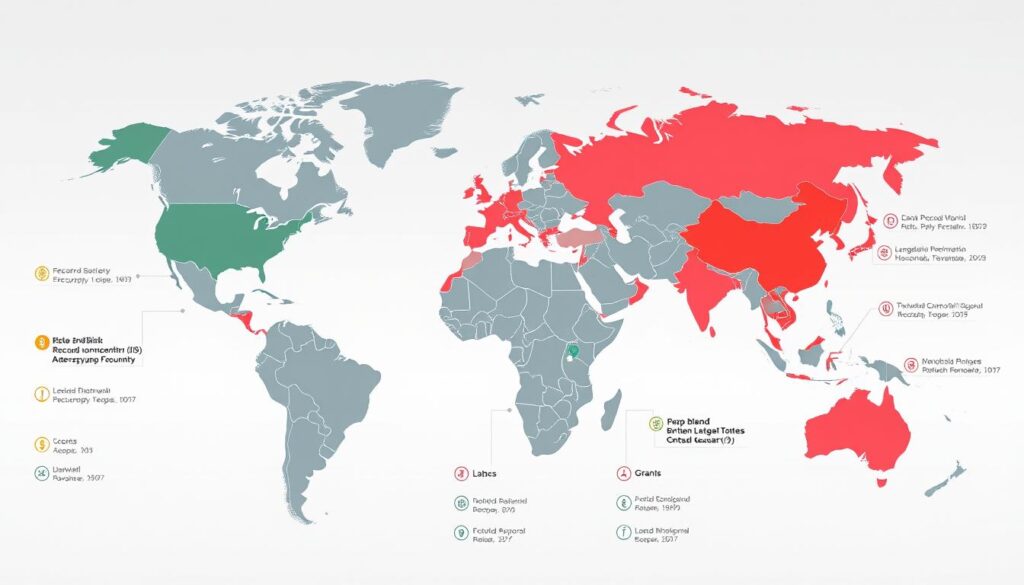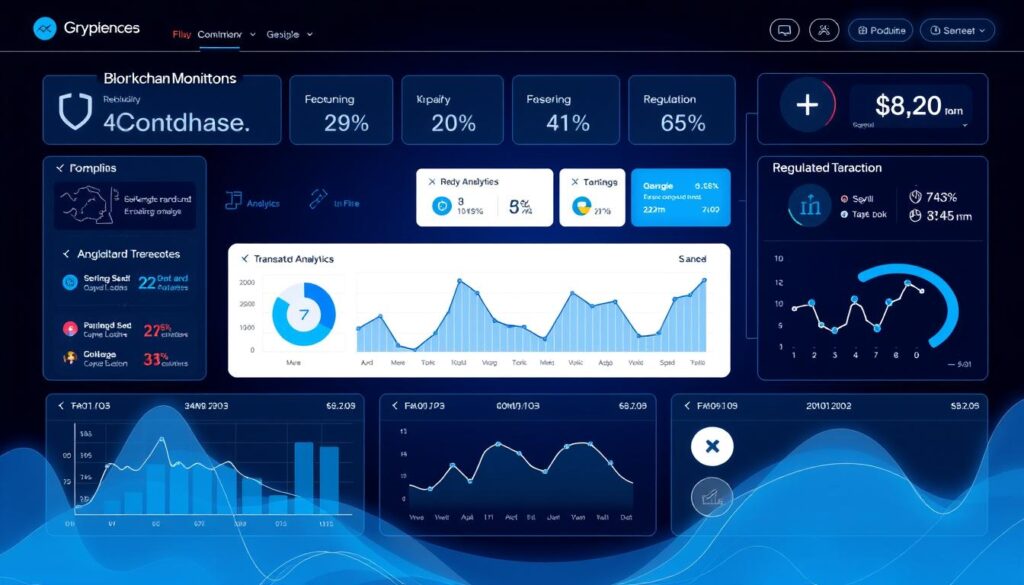Now Reading: Understanding Cryptocurrency Compliance Requirements for Businesses
- 01
Understanding Cryptocurrency Compliance Requirements for Businesses
Understanding Cryptocurrency Compliance Requirements for Businesses

This guide offers clear, practical information to help U.S. companies navigate evolving crypto rules and build risk‑based programs that regulators will recognize.
The federal crackdown — led by the SEC, CFTC, DOJ, FinCEN and OFAC — has increased enforcement across exchanges, ICOs, NFTs and stablecoins. Leaders such as SEC Enforcement Director Gurbir Grewal have warned about potential actions against compliance staff when programs fail wholesale.
Digital asset adoption has spread from teens to banks and funds, raising expectations for transparent information, strong security controls, and scalable practices that protect trust and market access.
This introduction previews key topics: AML/KYC under the BSA, Travel Rule expectations, sanctions screening, recordkeeping, third‑party oversight, testing, market surveillance, and cyber safeguards. It also highlights governance and leader accountability as central to reducing enforcement exposure and operational risk.
The U.S. crypto compliance landscape now: enforcement first, clarity second
Regulators have shifted into an active enforcement posture, using existing statutes to shape market behavior now. That means firms face fast-moving expectations while formal rulemaking catches up.
Regulatory heat is multi‑faceted:
- SEC: focuses on unregistered offerings under Howey and has brought dozens of enforcement actions.
- CFTC: targets derivatives and market manipulation.
- DOJ: pursues fraud and money‑laundering cases; FinCEN/OFAC enforce BSA and sanctions.
- State regulators add licensing and consumer-protection layers.

In 2023 the SEC filed 46 enforcement actions with more than $280 million in penalties, a sharp signal about velocity and cost. The Ripple ruling in March 2025 narrowed scope: public exchange sales of XRP were not securities while institutional sales were, producing a $50 million settlement and a recalibration of strategy.
With the SEC’s new Crypto Task Force and the GENIUS Act moving through the Senate, the rulebook is in flux. Companies must document legal analysis, risk assessments, and board‑approved policies to build a defensible narrative under current rules.
Core cryptocurrency compliance requirements for businesses
Start by mapping which product lines trigger federal money‑transmitter rules and state licensing obligations. That clarity guides how you apply AML and KYC controls across exchanges, custodial wallets, on/off‑ramps, and certain DeFi functions.

Mapping obligations to your activity
Assess MSB status early. If your platform accepts or transmits value, FinCEN likely treats it as an MSB under the BSA, which brings written AML programs, SAR filings, and a customer identification program.
- Tier onboarding with KYC/CIP checks tied to risk and transaction limits.
- Use blockchain analytics plus fiat monitoring to spot suspicious transactions and sanctions exposure.
- Operationalize the Travel Rule: send originator and beneficiary data on transfers over $3,000 and keep fallback messaging ready.
| Model | Main Obligation | Key Controls |
|---|---|---|
| Custodial exchange | MSB; state licensing | AML program, KYC tiers, Travel Rule messaging |
| Non‑custodial protocol | Case‑by‑case analysis | Legal memos, product change reviews, vendor audits |
| Third‑party provider | Support obligations | Contracts with audit rights, SLAs, data controls |
Document decisions and test controls regularly. Keep policies, training logs, and independent audits ready to show examiners and rely on industry guidance at industry guidance.
AML, KYC, and FinCEN’s BSA regime: building a defensible compliance program
A strong AML program is the backbone of any defensible BSA posture in the digital asset space. Firms must document roles, written procedures, training, and testing that scale to product risk.
Program pillars:
- Designate a BSA Officer and keep clear policies and procedures.
- Provide ongoing training and independent testing proportionate to risk.
- Cover crypto‑specific typologies in monitoring and audits.
Reporting requires timely SAR filings—generally within 30 days—and CTRs when applicable. Keep narratives, decision logs, and supporting information to support examiner review.

Operational essentials
Strengthen KYC/CIP by verifying IDs, screening for OFAC hits, PEPs, and adverse media, and re‑screen as risk changes. For transfers above $3,000, collect and transmit originator and beneficiary data and document fallback messaging.
| Pillar | Key Action | Why it matters |
|---|---|---|
| BSA Officer | Central oversight | Shows clear accountability to regulators |
| Monitoring | Blockchain analytics + fiat alerts | Detects mixers, darknet, sanctions exposure |
| Procedures | Onboarding to SARs | Supports audits and enforcement defense |
Enforcement actions like Bittrex and BitMEX show that failures can lead to heavy fines and individual penalties. Boards should fund and test the company program to reduce legal and tax exposure.
Operational controls that regulators expect to see
Regulators scrutinize operational controls as a window into an organization’s risk culture and practical defenses.
Retention policies must preserve trading data, P&L, chats, email, and system logs for defensible periods. Absence of records was a focal point in the FTX prosecutions, so document retention rationale and access controls.

Third-party due diligence
Assess vendors and service providers based on activity risk. Verify sanctions screening, resiliency, subprocessor chains, and data rights. Tie contracts to testing and audit access.
Independent testing and procedures
Schedule internal audits and external assessments to sample alerts, SAR workflows, Travel Rule messaging, and permissioning. Track remediation to closure and keep playbooks for investigations.
Market integrity and surveillance
Monitor for wash trades, pump-and-dump, velocity spikes, structuring, and linked counterparties. Route alerts into a documented SAR workflow and file within 30 days when warranted.
| Control | Purpose | Typical retention |
|---|---|---|
| Order book & ledger logs | Reconstruct trades | 5–7 years |
| Communications archive | Investigations & oversight | 3–7 years |
| Vendor due diligence files | Third-party risk proof | 5 years after contract end |
Security and data protection for digital assets: from policy to practice
Attackers focus on weak links—private keys, APIs, and UI paths—so controls must be layered and tested.
Safeguarding private keys requires technical and procedural measures. Adopt MPC wallets with hardware-backed isolation (for example, Intel SGX) and distribute key shares across multiple clouds to remove a single point of failure.
Harden key ceremonies: segregate duties, require multi-party approvals, log every step, and rotate shares on schedule. These steps reduce insider and external risk.
Preventing deposit address compromise
Defend addresses against man-in-the-browser attacks and clipboard spoofing by requiring test transfers on first-time counterparty payouts. Enforce allowlist-only withdrawals and protect the UI path from injection.
API key risk management
Apply least-privilege scopes, short-lived tokens, secure secret stores, and anomaly detection to spot bursts of trading or unusual transactions. Monitor key usage and revoke credentials immediately on suspicion.
IP blocking, cyber hygiene, and privacy
Use geofencing and IP blocking to limit access from sanctioned regions and log tests and exceptions for audits. Maintain patch SLAs, phishing-resistant MFA, zero-trust controls, and data inventories to meet GDPR and CCPA obligations.
| Control | Purpose | Recommended Frequency |
|---|---|---|
| MPC + hardware isolation | Eliminate single key failure | Continuous/annual review |
| Test transfers & allowlists | Prevent address tampering | Each new counterparty |
| API least privilege & monitoring | Reduce credential abuse | Real-time alerts; quarterly audit |
| IP blocking & logs | Block risky access | Continuous; monthly validation |
Navigating U.S. jurisdictions: New York DFS BitLicense, multi-state rules, and stablecoin developments
State rules now shape whether digital assets reach U.S. customers. New York’s DFS requires a BitLicense or a limited-purpose trust charter for many covered activities. That scope includes transmitting tokens, custody, operating exchanges, issuing assets, and out-of-state companies serving NY residents.
New York licensing and coin-listing
Follow DFS listing governance closely. The DFS now requires formal coin-listing policies and bans self-certification for certain token types. Align with the DFS Greenlist to reduce friction and prepare delisting playbooks to handle trading halts and customer settlement.
Operating across states and market access
Map money transmitter laws across jurisdictions and sync bonding, net worth, and exam expectations with MSB obligations under FinCEN. Build controls that satisfy regulators to preserve banking and on/off-ramp access with financial institutions.
Stablecoin outlook and tax readiness
The Senate passed the GENIUS Act in June 2025; track its progress and plan for issuer disclosure, reserves, and risk management if enacted. Also ensure systems capture transaction and trading data to meet federal and state tax reporting.
| Focus | Action | Why it matters |
|---|---|---|
| BitLicense scope | Assess activities that trigger licensing | Determines legal path and operational controls |
| Coin-listing policy | Formal reviews; avoid self-certifying tokens | Reduces delist risk and regulatory scrutiny |
| Multi-state mapping | Centralize licensing and bonding plans | Enables consistent market access |
| Stablecoin law | Monitor GENIUS Act; prepare issuer controls | Impacts reserves, audits, and product design |
Practical next steps: update policies, harmonize operations playbooks, test tax and transaction reporting, and engage proactively with DFS and other regulators. For detailed licensing guidance see crypto licensing requirements.
Conclusion
Today’s enforcement posture makes clear that documented processes and repeatable controls matter more than ever.
Operationalize a defensible, risk‑based program that covers AML/KYC, the Travel Rule, sanctions screening, market surveillance, and cyber security across all activity and transactions. Map obligations to each product and keep written policies, testing logs, and remediation evidence.
Boards and executives should review program metrics and resource gaps regularly. Combine on‑chain monitoring with platform telemetry, MPC key security, IP blocking, and strict API hygiene to boost resilience.
Stay ready: track DFS guidance, the GENIUS Act, and tax updates, and adapt controls promptly to protect market access. Strong controls build trust and help companies navigate continuous enforcement pressure.
FAQ
What federal agencies are actively enforcing rules on digital asset firms today?
Multiple agencies lead enforcement and oversight: the Securities and Exchange Commission (SEC) focuses on securities-law issues, the Commodity Futures Trading Commission (CFTC) handles commodity and derivatives matters, the Department of Justice (DOJ) pursues criminal cases, and FinCEN enforces anti-money laundering under the Bank Secrecy Act. State regulators such as the New York Department of Financial Services add licensing and consumer-protection scrutiny. Firms should plan programs that address obligations across all of these authorities.
How have recent court rulings and policy shifts changed the regulatory outlook?
Recent decisions and agency signals — including cases that narrowed or clarified what counts as a security — have prompted the SEC to refine approaches, while Congress and regulators explore targeted reforms. Enforcement-first activity remains prominent, so firms must document risk assessments, remediation steps, and legal analyses to demonstrate good faith compliance while rules evolve.
Which core obligations apply depending on my activity: exchange, custodian, DeFi protocol, or service provider?
Obligations map to activity. Licensed exchanges and custodians generally face the strictest oversight on custody, anti-money-laundering programs, and market surveillance. Money-services providers and wallets may trigger money transmitter laws and MSB registration. DeFi protocols pose unique challenges around decentralization, but service providers that operate, host, or market protocols often inherit regulatory risk. Conduct a legal and operational mapping exercise to identify registrations, licensing, and programmatic controls you need.
What are the essential elements of a defensible AML program under the BSA?
A risk-based AML program includes: a written risk assessment; policies and procedures; a designated compliance officer; ongoing employee training; transaction monitoring calibrated to risk; timely SAR and CTR reporting; and independent testing. Maintain documentation showing how monitoring rules are tuned and how alerts are triaged to reduce false negatives and false positives.
What should KYC/CIP processes include for customers and counterparties?
KYC/CIP should verify identity, collect beneficial ownership data for entities, screen sanctions, PEPs, and adverse media, and apply enhanced due diligence for higher-risk relationships. Use layered verification—documentary evidence, digital ID checks, and transaction behavior—to build a reliable customer profile and support ongoing monitoring.
How does the Travel Rule apply to digital asset transfers today?
The Travel Rule requires transmission of originator and beneficiary information for qualifying transfers. Implementation depends on the value, counterparty type, and whether counterparties are covered financial institutions. Many firms use secure messaging solutions, compliance gateways, or vendor services to transmit required fields while maintaining privacy and integrity of data.
What are the practical steps to avoid sanctions exposure and related enforcement risk?
Screen counterparties against OFAC and other national sanctions lists in real time, block or reject transactions involving sanctioned parties, and preserve audit trails. Conduct enhanced reviews when alerts arise, and maintain a sanctions escalation policy. Recent enforcement actions against exchanges and individuals show regulators expect proactive sanctions risk management tied to transaction monitoring.
What recordkeeping and retention policies do regulators expect?
Regulators expect defensible retention of trading records, customer onboarding data, transactional logs, and communications (including chat and email) for specified statutory periods. Policies should specify retention durations, secure storage, access controls, and procedures for lawful production during examinations or investigations.
How should firms manage third‑party risk with vendors and service providers?
Implement onboarding due diligence, contractual obligations for data protection and regulatory cooperation, ongoing monitoring, and periodic risk reviews. For cloud providers, custodians, and analytics vendors, require evidence of security audits, incident response plans, and the right to audit where appropriate.
What role do independent audits and testing play in regulatory expectations?
Independent testing—via internal audit or external third parties—validates controls, finds gaps, and demonstrates proactive governance. Regulators expect periodic testing of AML systems, security controls, and reconciliation processes. Test results and remediation plans should be documented and tracked to closure.
How do firms detect and prevent market abuse like manipulation or layering?
Deploy market surveillance tools that flag anomalies such as wash trades, spoofing, velocity spikes, and structuring. Combine automated detection with human review and robust SAR workflows. Keep detailed order and execution histories to support investigations and regulatory reporting.
What are best practices to safeguard private keys and custody operations?
Use multi-party computation (MPC) or hardware security modules (HSMs) to split signing authority, enforce multi-signature controls, and keep cold-storage processes stringent. Implement role-based access, key rotation policies, and thorough change-management procedures to reduce single points of failure.
How can firms prevent deposit address compromise and related fraud?
Enforce hardened processes: require test transfers for new addresses, maintain strict whitelisting, separate address generation from customer-facing systems, and monitor for unusual incoming patterns. Combine these controls with rapid incident response to limit exposure when compromise occurs.
What controls should be in place for API key management and developer access?
Apply least-privilege principles, require short-lived keys where possible, enforce secret rotation, log all API activity, and alert on abnormal patterns. Maintain a developer access governance model and revoke credentials promptly when no longer needed.
How do privacy laws like CCPA or GDPR intersect with digital asset operations?
Privacy laws impose obligations around data subject rights, data minimization, and lawful bases for processing. Firms operating across the U.S. and EU must map personal data flows, implement data protection policies, and balance privacy rights with regulatory recordkeeping and suspicious-activity reporting obligations.
What licensing and state-level rules should firms consider when operating in the U.S.?
New York’s BitLicense and trust charter set high standards for custody, AML, and consumer protections. Other states enforce money transmitter laws and MSB registration. Determine whether you need a BitLicense, money transmitter licenses, or state-specific approvals before offering services in particular jurisdictions.
How do money transmitter and MSB classifications affect market access?
Classification as an MSB or money transmitter triggers registration with FinCEN, state licensing in some jurisdictions, and specific operational controls. These classifications shape permissible services, compliance obligations, and how you contract with banks and other financial institutions.
What should businesses prepare for regarding stablecoin regulation and proposed federal acts?
Expect increased scrutiny on reserves, disclosures, and redemption mechanics. Legislative proposals aim to define standards for issuer governance, reserve audits, and consumer protections. Prepare robust reserve attestations, transparency reporting, and contingency plans for runs or depegs.
How can small firms build a practical, proportionate risk program with limited resources?
Prioritize a scaled, risk-based approach: document a clear risk assessment, implement core controls (KYC, transaction monitoring, sanctions screening), use vetted vendor solutions to outsource complexity, and schedule periodic independent reviews. Focus resources on the highest-risk pathways and maintain records that show a reasoned compliance strategy.
What are common enforcement triggers that lead to penalties or criminal cases?
Common triggers include weak or absent AML programs, failure to register when required, sanctions violations, market manipulation, faulty custody practices, and poor recordkeeping. Regulators often target firms with repeated or systemic failures, but lapses in governance and documentation can also prompt actions.
How should firms respond to a regulator or law-enforcement inquiry?
Respond promptly with a designated legal and compliance team, preserve relevant records, and produce required information under counsel. Cooperate transparently, but limit voluntary disclosures without legal guidance. Demonstrating remediation measures and prior good-faith efforts can mitigate outcomes.
What metrics and reporting should senior management expect from compliance teams?
Provide dashboards on alert volumes, SAR filings, high-risk customer onboarding, transaction volumes by risk tier, remediation closure rates, third-party risk findings, and results of audits. Regular, concise reporting helps boards and executives make informed risk decisions.
















